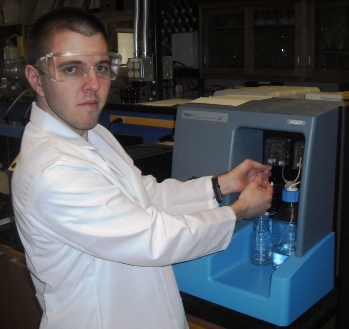May 14 2013
NanoSight reports on how Nanoparticle Tracking Analysis, NTA, is being used at the University of Wyoming in the characterization of the physical and interfacial properties of manufactured nano materials.
Dr Jonathan Brant is leader of the group, "Interfaces in the Environment: membranes, particles and nanotechnology" in the College of Engineering and Applied Science at the University of Wyoming. The group focuses on problems associated with physicochemical processes in engineered and natural environmental systems. Understanding and ultimately controlling the many complex mechanisms that occur at environmental interfaces may resolve many of these problems.
As is the case for environmental engineering as a whole, their work falls at the junction of many different disciplines, including colloid and interface science, chemical engineering, nanotechnology, microbiology and materials science.
Nanomaterials need to be characterized in terms of their size and distribution. Dr Brant explains the background to his work: "We have two primary research tracts. First, we characterize the properties of manufactured nano materials including TiO2, nano-Ag, C60 and maghemite of varying functionalities in aqueous systems. Secondly, we characterize the transformation of manufactured nano materials and their removal in conventional and advanced water treatment processes.
In both instances, we have chosen NTA to characterize the size and size distribution of the particle suspensions under varying conditions. The latter area does this as well as quantifying the particle number concentrations in an effort to better understand the "dose" or concentrations of nano materials in drinking water."
Describing his practical choices for NTA, Dr Brant continues: "I also use a dynamic light scattering (DLS) system from Malvern as well as TEM imaging (particle counting from images as well as geometry assessments from images). However, using NTA allows us to work with polydisperse suspensions (DLS is very limited in this respect) and it provides us with a number count for nano materials, which is a first step in better characterizing nanoparticle concentrations. While the NTA may not be perfect here, it is our best option."
To find out about the company and to learn more about particle characterization using NanoSight's unique Nanoparticle Tracking Analysis solutions, visit www.nanosight.com and register to receive the next issue of NanoTrail, the company's electronic newsletter.
 Erik Pfeiffer, a graduate student in the Brant Group, using a NanoSight NS500 at the University of Wyoming.
Erik Pfeiffer, a graduate student in the Brant Group, using a NanoSight NS500 at the University of Wyoming.
About NanoSight
NanoSight delivers the world's most versatile and proven multi-parameter nanoparticle analysis in a single instrument.
NanoSight's "Nanoparticle Tracking Analysis" (NTA) detects and visualizes populations of nanoparticles in liquids down to 10 nm, dependent on material, and measures the size of each particle from direct observations of diffusion.
Additionally, NanoSight measures concentration and a fluorescence mode differentiates suitably-labelled particles within complex background suspensions. Zeta potential measurements are similarly particle-specific. It is this particle-by-particle methodology that takes NTA beyond traditional light scattering and other ensemble techniques in providing high-resolution particle size distributions and validates data with information-rich video files of the particles moving under Brownian motion.
This simultaneous multiparameter characterization matches the demands of complex biological systems, hence its wide application in development of drug delivery systems, of viral vaccines, and in nanotoxicology. This real-time data gives insight into the kinetics of protein aggregation and other time-dependent phenomena in a qualitative and quantitative manner. NanoSight has a growing role in biodiagnostics, being proven in detection and speciation of nanovesicles (exosomes) and microvesicles.
NanoSight has installed more than 500 systems worldwide with users including BASF, GlaxoSmithKline, Merck, Novartis, Pfizer, Proctor and Gamble, Roche and Unilever together with the most eminent universities and research institutes. NanoSight's technology is validated by 700+ third party papers citing NanoSight results.
NanoSight's leadership position in nanoparticle characterization is consolidated further with publication of an ASTM International standard, ASTM E2834, which describes the NTA methodology for detection and analysis of nanoparticles.